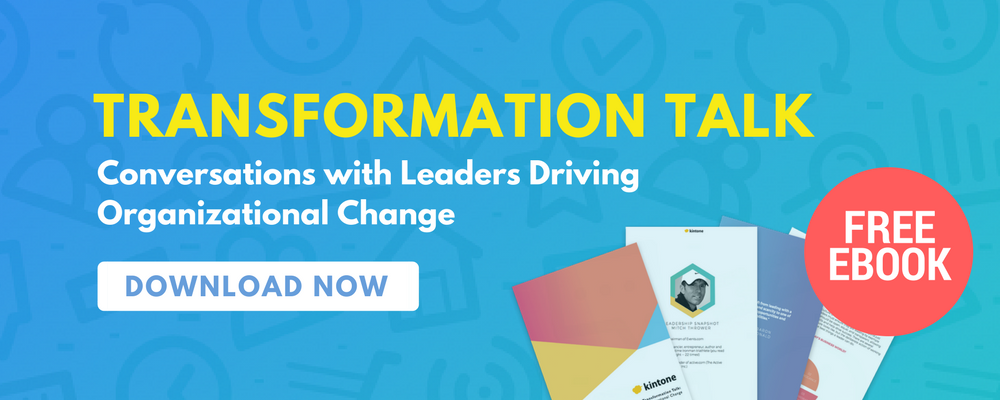2017 is proving to be a make or break year for IT and operations leaders involved in digital business transformation.
Building an organization that can change both its technology and culture rapidly is a core part of any modern business strategy expecting to not only to survive, but thrive long into the future.
As our relationship to technology changes and the marketplace evolves, organizations will need to win over customers (including employees) with thoughtful, well-executed experiences and solutions.
Overwhelmingly complex at a times, digital transformation cuts into many different areas of an organization with plenty of lessons to learn for both long-term adapters and newbies alike.
 In this week's episode of Transformation Talk, we chatted with a process improvement leader who has successfully led enterprise-level change for over 20 years.
In this week's episode of Transformation Talk, we chatted with a process improvement leader who has successfully led enterprise-level change for over 20 years.
Gregory North designs and deploys process-centric and digitally enabled operating models for a wide-range of organizations. His career spans many industries including public sector, financial services, healthcare, wireless communications, and aerospace. Prior to launching Globe North, his process management and business transformation consulting firm, he was Chief Process Officer for Xerox Services.
How would you describe the current state of operational excellence?
Operation excellence today is not dissimilar from when I began many years ago in manufacturing. At that time, the buzzwords were things like analytics, automation, process excellence. It was all about how can we take the risk of error out. It was robotics in a manufacturing context. Today, we’re beginning to look at those questions in an office or services context.
What are some industries that have an opportunity to improve process excellence?
First let’s take financial services. That industry in general has had tremendous success over the last three to five years in automating end to end processes in such a way that they’re achieving “straight-through” processing. It means that their digital transformation exercises have resulted in taking 100% of the manual labor out.
This is an example of where understanding the process and being able to design it effectively has resulted in effective automation in the banking workplace. Process excellence, in that context, has created more efficient and effective processes, which otherwise could never have been realized.
The challenge for operational excellence today is the design of processes for technology organizations who are focused on the tool, not the customer. If the decision making is carried out by people more interested in the tech than customer experience, we’re forgetting how valuable process excellence could be in this exciting, new technology context.
Where do you think the most potential exists for robotic process automation (or RPA) in the process landscape?
RPA can be a very effective suite of tools any time where you have a transaction which is simple, frequently repeated, and in some cases, requires information to be re-keyed from one system into another. If you have a single unit of information being acted on repeatedly in the same way, you can automate it, and there’s an opportunity to leverage RPA.
If you’re walking into a health care provider, for example, you might give information to the intake staff that’s later going to be used in other departments. As you move through the process, are people re-keying the information? Or is it being effortlessly moved through each step with a workflow defined by RPA?
How can leaders engage employees when moving toward a process excellence culture?
When the discussion is about automation, you should be careful as a leader not to over-state the role of technology and under-emphasize the criticality of an outstanding work force. Ultimately, talent wins the battles of the 21st century. Organizations that do the best job of satisfying their customers are ones that do a great job recognizing the value of employees.
You need to put your employees at the center of your conversations, and provide a clear and candid vision of the future. If you’re going to have a more automated world, explain to your employees how they’re part of making that happen. Instead of thinking about it as a displacement situation, think about it as an opportunity for enhancement.
What advice can you give to overcome resistance to change with multiple stakeholders?
I get asked that question all the time. Often, I hear it as, "Employees resist change, what do you do to overcome that employee resistance?" I must take exception with the assumption that it's a fundamental aspect of human nature that people resist change. People resist change when they don’t know what’s in it for them.
More than ever before, it’s critical that leaders help employees understand that change will be a constant part of their lives, and the winning organizations are the ones who can make the best adjustments in real time. You need to make change your ally, not your enemy. You play those cards with your employees, they will pick them up and they will help you play a winning hand going forward.
What skill-sets should we look for in employees?
The word “agility” is critical. We need mental agility, a willingness to adjust quickly on the fly when new information comes, and act on it. That is paired with strong information synthesis: the ability to take information rapidly from a variety of sources and synthesize it from information into insight. That insight then can be leveraged in a way that can be effectively communicated and shared with their fellow employees. That’s going to make the whole team better.
The second skill set is collaboration. The first was about what individuals can do, the second is how they work with the rest of the team. More and more organizations are not only virtual, but they also partner and ally frequently with third parties, so collaboration skills are critical.
What’s the value of being able to use technology to build a process, execute it, and change it in real time?
If you can rapidly assess the market you’re operating in, and act upon it in minutes, you will get a tremendous advantage over your competition. Let’s take online retail today: if you’re in the last ten shopping days before the holidays, and you have an aligned digital supply chain that can ramp up on the most interesting offers and attract more customers, you can be the dominant player in that space.
We’re moving to a time where the ability to be real-time is going from a competitive advantage to a requirement; that’s both exciting and scary at the same time.
Can you tell us more about your firm, Globe North, and some of the operational excellence leadership programs you’re currently developing?
Globe North’s hypothesis is that excellence is not a random occurrence. It begins with having sound strategy. We focus on strategy and strategy execution, and provide advisory services to help leadership teams assess their strategic focus.
When we talk to organizations, what we find most often is that they have a good sense of their mission, but they haven’t aligned their strategy to get that done. Our job is to help them position their organizations for excellence going forward.
Have a question for Gregory? Interested learning more about Globe North? Get in touch:
Visit http://globenorth.com/
Follow on Twitter @GregoryNorth
About the Author
Nicole is Director of Marketing at Kintone, with 10+ years experience in content strategy, campaign management, lead acquisition and building positive work cultures of empowered, purpose-driven team members. She spent seven years as a journalist, previously serving as a CBS San Francisco digital producer, NPR contributor, Patagon Journal deputy editor and reporter for several publications, including the Chicago Tribune. She's passionate about the tech for good space, social entrepreneurship and women leadership. On the weekends, you’ll likely find her putting her Master Gardener skills to use in at community gardens in Oakland.



.png)







